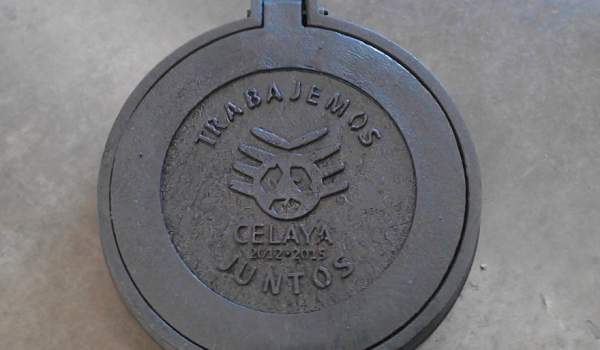
Words and Photos by Michele Perez
The Challenge: The Cost of Theft of Iron Manholes and Street Grates
The city of Celaya had a problem. Located in the state of Guanajuato, Mexico with a population of about 500,000 the city faced a costly and tedious issue: the city’s iron manhole covers and street grates were being stolen and sold for the iron. In 2013, there were approximately 100 manhole covers and 647 street grates stolen. The cost to the city to replace each iron manhole cover was between $1,300-1,700 MXN pesos ($99-120 USD at current exchange rates), and about $430 MXN ($32 USD) for the grates, including materials and labor. In total, the city spent approximately $428,210 MXN ($32,686 USD or €23,720 EUR) for iron replacements. The city tried replacing them with concrete manhole covers, but those broke too easily. For an ever-expanding city like Celaya, it was a nuisance and an unnecessary expense for the city and taxpayers, and a better solution was desperately needed.
The Opportunity: A Smart and Effective Existing Waste Management System
 Celaya already had a robust garbage collection system that included separation of reusable materials at the municipal dump. 300 tons of garbage was collected daily and through the use of machines and manual labor, workers separate out fabric, glass, cardboard, aluminum, and plastics. After separating plastics by color, they are then compacted and the municipality sells the materials for revenue, which has become a more common practice around the globe. Additionally, Celaya uses the biogas produced from the garbage in the dump as renewable energy. This is all part of the “Campo Limpio” (Clean Fields) national and local program to reduce waste, recycle and upcycle as much of the garbage as possible. Upcycling is reusing discarded objects or material to create a product of a higher quality or value than the original intention— in other words, taking garbage or discarded items and recycling them into a product or item that can be used anew.
Celaya already had a robust garbage collection system that included separation of reusable materials at the municipal dump. 300 tons of garbage was collected daily and through the use of machines and manual labor, workers separate out fabric, glass, cardboard, aluminum, and plastics. After separating plastics by color, they are then compacted and the municipality sells the materials for revenue, which has become a more common practice around the globe. Additionally, Celaya uses the biogas produced from the garbage in the dump as renewable energy. This is all part of the “Campo Limpio” (Clean Fields) national and local program to reduce waste, recycle and upcycle as much of the garbage as possible. Upcycling is reusing discarded objects or material to create a product of a higher quality or value than the original intention— in other words, taking garbage or discarded items and recycling them into a product or item that can be used anew.
The plastics are taken to a sorting, recycling, and upcycling facility in the nearby industrial complex area of Recicladora de Plásticos de Celaya, or “Plastics Recycler of Celaya”. The facility sorts out the polythene plastics by color, and then runs the bottles and containers through a mill that reduces them into approximately one-inch square pieces. The reusable material is further cleaned by a machine and then set for the removal of labels and stickers. Once fully cleaned, items continue on to a mill that turns plastics into pellets that resemble black or gray confetti. Pellets are then molded to create upcycled materials like plastic “wood” planks of various widths and lengths used for park benches, small storage units, and even portable toilets. These pellets can be heated and formed into any shape, based on the form of the mold.
The Solution: Strategic Redesign of Manhole and Grate Covers
As a solution to resolving the underground market of stolen and resold iron manhole and grate covers, architect/designer at Recicladora de Plasticos came up with an affordable, durable solution based on an upcycled plastic design. Each new plastic manhole cover costs $800 MXN ($61 USD), a savings of $500-900 MXN ($38-69 USD) each. Upon deciding to replace all 19,000 covers there would be a minimum savings of $9.5million MXN ($722,000 USD)— a sizable amount of funds that could be directed to more worthy causes.
The city is making municipal improvements to many sections of the city and the plastic manhole covers and grates serve as an ideal replacement in the semi-arid environment of Celaya. To date, none of the plastic versions have been stolen and it has saved the city in both financial and environmental costs. A clear example of how the city’s waste is upcycled into another use for the city’s residents.
*All details were from in-person interviews and correspondence with Mayor Ismael Perez Ordaz’s office of the City of Celaya and Recicladora de Plásticos de Celaya.
About the Author
Michele Perez

Michele Perez is currently a freelance writer, editor, and Design Manager. Having received a Master’s Degree from Pratt Institute in Design Management (2005), she has worked with a variety of companies as a project manager and strategic designer, making sustainable business decisions and principles central to her purpose. Her interests include creative business, sustainability, education, and the thoughtful implementation of a good design process.




